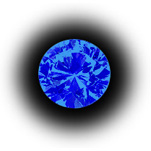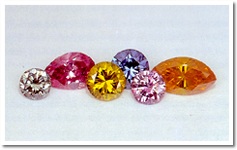

 |
 |
 |
a trend creation |
 |
 |
 |
| History | Cut |
Color |
Clarity |
Carat |
Famous |
Color Stone |
Birth Stone |
Care | How to Buy |
COLOR

Diamond colors
generally range
from D - X for white and yellow Diamonds. D is the whitest. Around S,
they
become "Fancy" yellow Diamonds. One can also find green pink, red,
blue and brown diamonds - though these are usually irradiated.
Refers
picture to the degree
to which a diamond is colorless.

Diamonds range in
color from
icy winter whites to warm summer whites. Diamonds are graded on a color
scale
established by the Gemological Institute of America (GIA) which ranges
from D
(colorless) to Z. Warmer colored diamonds (K-Z) are particularly
desirable when
set in yellow gold. Icy winter whites (D-J) look stunning set in white
gold or
platinum. Color differences are very subtle and it is very difficult to
see the
difference between, say, an E and an F. Therefore, colors are graded
under
controlled lighting conditions and are compared to a master set for
accuracy.
Truly colorless stones, graded D, treasured for their rarity, are
highest on
the Diamond Picture. Color, however, ultimately comes down to personal
taste.
Ask a jeweler to show you a variety of color grades next to one another
to help
you determine your color preference.
Fluorescence:
Fluorescence is
an effect
that causes a diamond to glow under ultra violet light (UV). The 50% of
diamonds have fluorescence. The glowing is usually in the color of
blue, but
occasionally other colors are noticeable- predominantly yellow. Strong
fluorescence can cause a diamond to look "hazy" or less transparent.
D-G colors with strong fluorescence are usually slightly cheaper than
similar
stones without fluorescence.
The following are
the
possible grades given to fluorescence:
None - Faint - Medium - Strong -
Very strong
All certificates
denote the
diamond's fluorescence as well as color.

Rare
Natural Wonders:
Nature has given
birth to
many colorful creations. The colors of flowers, seashells and
butterflies
inspire heights of pleasure. Like pieces of a rainbow, frozen in time
for
eternity, nature has also created diamonds in colors.
Colored diamonds
are very
rare. They exist mostly in one carat and smaller sizes, although yellow
diamonds exist in large quantity sizes. A beautiful colored diamond
does not
have the saturation of other colored stones. Their colors are generally
subtler, but they exude a living energy that only the brilliance of a
diamond
possesses. Unlike colorless diamonds, which are cut for maximum
brilliance and
fire, colored diamonds must be cut for a balance of brilliance while
maintaining their color. Thus, we cannot hold them to the proportion
standards
of colorless diamonds.
Whether it is an
emotional
inspiration or a lucky charm, a symbol of love or a source of power, a
collector's item or worn in a piece of jewelry, a fancy color diamond
is a gift
that will be cherished for a lifetime.

Did you know
that diamonds
come in every color of the rainbow?
Grading color in
the normal
range involves deciding how closely a stone's body color approaches
colorlessness. Most diamonds have at least a trace of yellow or brown
body
color. With the exception of some natural fancy colors, such as blue,
pink,
purple, or red, the colorless grade is the most valuable. If a diamond
does not
have enough color to be called fancy, then it is graded in a scale of
colors
ranging from Colorless to Light Yellow, "D" through "Z". A
diamond with a "D" color is considered colorless. If the color is
more intense than "Z", it is considered fancy. A fancy yellow diamond
fetches a higher price than a light yellow diamond. The Laboratories
only grade
diamonds that are un-mounted or "loose” and they do so under special
light. Once a loose diamond is mounted on a ring, even the trained
professional
cannot always tell the difference between, say a "D" color and an
"E" or "F" color diamond!
How much
does
"color" affect cost?
The effect of all
the different
properties of Diamond on Cost is discussed in more detail in the Cost
section.
For color, let's take a typical Diamond for an example, and see what
happens
when we take it through different color grades. Let's start with a
1.00-carat
Diamond of K color and VS1 Clarity. If you move up to an H color, you
will pay
approximately an extra $1,700 per carat. Move up to F color, the
increase will
be approximately $1,100 per carat ($1,700+1,100=2,800). Improve the
color to D
and the increase will be approximately $900 per carat
($2,800+900=3,700)
Clarity.
